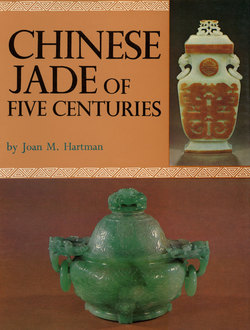Читать книгу Chinese Jade of Five Centuries - Joan M. Hartman - Страница 10
На сайте Литреса книга снята с продажи.
ОглавлениеPreface
There is a tendency to scorn Chinese jade of the 14th through 18th centuries as being inferior, one of the minor decorative arts, not worthy of inclusion in the fine arts category. Scholars are preoccupied with ancient civilizations. There is an aura about broken bits of pottery and corroded bronze tools which sometimes defies comprehension. Granted, these specimens do provide an insight into the culture of people who lived a few thousand years ago and are fascinating from an archeological point of view. But aesthetically speaking, we cannot favorably compare the crude, rough form of a jade pi or ts'ung to the warm, sensitive figure of the buffalo (Plate 9) from the Ming dynasty or the stately splendor of the white jade covered jar (Plate 28) of the Ch'ien-lung period. It is ludicrous to discuss the beginnings of the medium in the minutest detail, and then proceed to simply discount the fully developed artistic quintessence of the later carvings. Tomb jades have their special place in the first chapters of the story of Chinese art, but for pure artistic accomplishment these later jades cannot be equaled.
Jade carving is an art form. And art is a reflection of the joys, dreams, and fervent beliefs of the people who create it. I have tried to convey the traditional Chinese philosophy and way of life by including brief descriptions of the court, pertinent historical data, and through an interpretation of the symbolism which appears on these jades. This approach is not new, as Couling averred: "A study of the objects made in this hard stone is of inestimable value for the comprehension of Chinese psychology" [8].*
There has certainly been too much unfactual, overly romantic nonsense written on the subject. By the same token, however, it is a pity to discuss this beautiful sculpture in dry, technical terms on the assumption that accuracy is preferable to any attempt at appreciation. So I have endeavored to combine fact with an awareness of aesthetics and the nature of man. In the final analysis it is the Chinese people who shine forth in these jade carvings, their reverence for the stone ascribed to by Confucius when he stated, "... wise men have seen in jade all the different virtues. It is soft, smooth and shining, like kindness; it is hard, fine and strong, like intelligence; its edges seem sharp, but do not cut like justice; it hangs down to the ground, like humility; when struck, it gives a clear, ringing sound, like music; the stains in it, which are not hidden and which add to its beauty are like truthfulness; its brightness is like Heaven, while its firm substance, born of the mountains and the waters, is like the Earth. The Book of Poetry says, 'When I think of a wise man, he seems like jade.' That is why wise men love jade" [18].
Chinese art has always been of interest to Americans, as witness the great connoisseurs of the turn of the century—J. P. Morgan, Benjamin Altman, Heber R. Bishop, T. B. Walker—and the tradition continues with men like Avery Brundage, whose collection of Oriental art is now housed at the de Young Museum in San Francisco.
The author has traveled throughout the United States in search of jade, and has purposely selected examples from U.S. museums only, as most of these collections have received little attention recently. The pieces herein are but a sampling of the rich treasure in American galleries.
Quite a few of the jade carvings in this volume are not on exhibition at present. It is deplorable how much jade and other fine art is hidden away in museum storerooms! There are, of course, some pieces which are so close in style to that which is already on display that it would be superfluous to exhibit them. I suggest that perhaps these articles could be loaned to other museums whose collections are not as adequately endowed. Again, there are jades which do not meet museum standards of quality. Possibly these pieces could be lent to schools for study purposes. In any case, I hereby make an urgent plea for a clean sweep so that jades and other objets d'art, as well, will once again reflect the light of day and we will all have the opportunity to reap their aesthetic rewards.
JOAN M. HARTMAN
Footnote
* Numbers in brackets refer to entries in the Bibliography at the back of the book.
